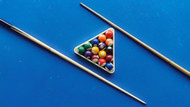How to Rack a Pool Table - The Proper Way to Rack Pool Balls
Posted by Home Billiards on 23rd Oct 2023
As small a part of the game as it may seem, racking in pool is one of the most influential factors in fair, reliable, and enjoyable play.
Whether you’re stepping up to the felt in a bar or at home, this guide aims to give you everything you need to set up a pool table every time.
Key takeaways TL;DR
Below, you’ll learn:
- The rules for racking a pool table according to the major regulating bodies
- The equipment you’ll need for racking
- How to rack 8-ball, 9-ball, snooker, and straight pool
- How to ensure a tight rack every time
Chalk your cues; let’s jump in.
Rules for racking a pool table
There are three popular rule sets for playing pool: two from regulating bodies and one more casual rule set developed from playing in bars.
Racking with BCA rules
The Billiard Congress of America (BCA) uses World Pool Association (WPA) rules, which state the following racking rules:
- Balls must be racked in a triangle at the foot of the table.
- 8-ball in the centre of the triangle.
- The first ball of the rack is on the foot spot.
- A striped ball is in one corner of the rack, and a solid ball is in the other corner.
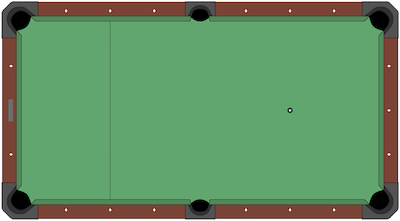
By SMcCandlish - Self-made (based on proportions provided by images from CueTable.com), CC BY-SA 4.0, https://commons.wikimedia.org/w/index.php?curid=3...
This helps ensure fair play by putting the black ball squarely in the middle of the pack and different colours on either side of the triangle.
If the black ball does get sunk during the break, this doesn’t mean a win or loss; the BCA ruleset states the game must be restarted.
Racking with APA rules
The American Players Association (APA) states the following racking rules:
- Balls must be racked in a triangle at the foot of the table.
- Balls must be racked by the non-breaking player.
- The 8-ball is in the centre of the triangle.
- The first ball of the rack is on the foot spot.
- The rest of the balls can be placed in any order (at least in 8-ball, see below for how the rules differ for 9-ball).
- The breaking player may request and receive a rerack.
- The loser of the lag, and/or the loser of any subsequent game, racks for the opponent.
This ruleset is more casual, which might appeal to beginners or easy-going players. However, one downside is that the APA ruleset can result in less fair games because there are fewer rules around ball placement during racking.
For example, picture all solids on the perimeter of the rack; obviously, this will make it easier to sink more solid balls off the break. The same goes if there are only stripes on the outside.
Racking with bar rules
Now, perhaps the most popular set of rules: bar rules.
Bar rules aren’t written in stone like BCA or APA rules are; they’re more agreed upon on a player-by-player basis.
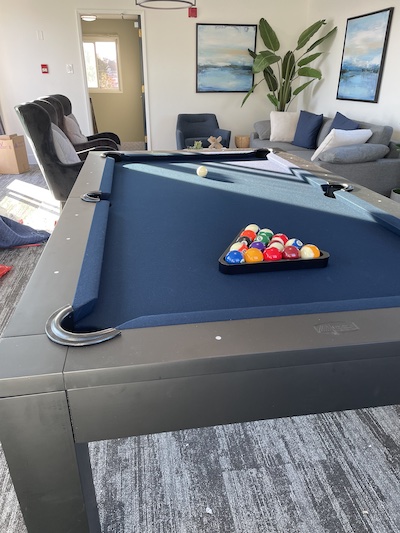
With this in mind, you can pick and choose from the APA and BCA rules above as you like (or do your own thing); as long as you and the other player agree on the rules, that’s all that matters.
What tools do you need to rack a pool table?
You’ll need a ball rack (either an 8-ball triangle ball rack or a 9-ball rack), sometimes called a triangle, and a pool table with proper foot and head markings to properly rack a pool table.
Pool ball rack
A pool ball rack is a tool used to arrange balls into a specific formation before the break shot. Triangle racks are used for 8-ball, diamond racks for 9-ball, and template racks ensure tighter, more consistent setups. Often made of plastic, wood, or metal, the rack ensures proper placement and fair starting conditions.
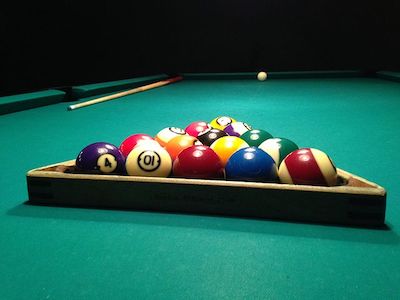
Pool table with Head and footstring markings
Headstring and footstring markings on a pool table divide it into zones for gameplay. The headstring runs horizontally near the table's head and marks where the cue ball starts. The footstring lies near the rack area and helps align the rack. These markings guide breaks and positioning.
You'll also need a table with the right head and foot markings to know where to place the tip of your rack (top of the triangle). These are small circles on either side of the table, with the tip of the rack going on the foot (located on the bottom of the table) and the white cue ball on the head (located on the top of the table).
If you’re playing casually, you can often eyeball the right placement. But head and foot markings are used for more serious, competitive play.
How to expertly rack a pool table (in different types of pool)
As you know, there’s not just one way to play pool. There’s 8-ball, 9-ball, snooker, straight ball, and other variations.
With this in mind, you may be asking yourself: Are racking rules different for 8-ball pool compared to 9-ball pool? How about snooker compared to straight pool?
Let’s look at how to set up your rack for different kinds of pool.
How to set up an 8-ball rack
To set up an 8-ball rack properly and fairly, follow these steps:
- Identify the foot side of your table, often indicated by a small circle in the middle width-wise (the head side will often have this circle too but with a line, called “the string”, going through it).
- Place the apex ball (often the 1-ball) inside your triangle rack directly on top of the foot marking.
- Place a stripe ball in one of the bottom corners of your rack.
- Place a solid ball in the other bottom corner.
- Place the 8-ball directly in the middle of your rack.
- Place the rest of the balls in the open space in your rack however you want.
- Ensure balls are tightly packed together (gaps can cause ineffective and unfair breaking).
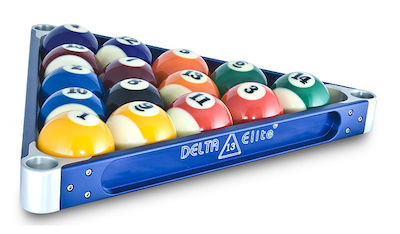
By 1sttimeright - Own work, CC BY-SA 3.0, https://commons.wikimedia.org/w/index.php?curid=7...
How to set up a 9-ball rack
To set up a 9-ball rack properly and fairly, follow these steps:
- Identify the foot side of your table.
- Place the apex ball inside your diamond rack directly on top of the foot marking.
- Place the 9-ball directly in the middle of your rack.
- Place the rest of the balls in the open space in your rack however you want (unlike 8-ball, balls can be placed randomly throughout the rack in 9-ball).
- Ensure balls are tightly packed together.

By Kafziel at the English-language Wikipedia, CC BY-SA 3.0, https://commons.wikimedia.org/w/index.php?curid=5...
How to set up a snooker table
There’s no rack in snooker like there is in pool, but there are still steps to properly up a snooker table.
To set up a snooker table properly and fairly, follow these steps:
- Identify the foot of the table, the side without the black line running from side to side (called the baulk line).
- On the foot side, place the 14 red balls in a triangle with the pink ball at the apex and the black ball behind the triangle.
- Ensure the triangle is tightly packed together.
- Place the blue ball in the middle of the table length-wise.
- Place the brown, yellow, and green balls on the opposite side of the table from the triangle (head side), in a line along the baulk line.
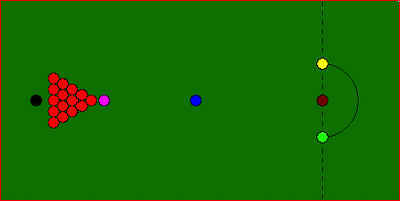
By Jupiler, CC BY-SA 3.0, https://commons.wikimedia.org/w/index.php?curid=1793478
Racking the balls for straight pool
To set up a straight pool rack properly and fairly, follow these steps:
- Identify the foot side of your table.
- Place the apex ball (anything but the 1-ball) inside your diamond rack directly on top of the foot marking.
- Place the 1-ball in the bottom right corner of the rack.
- Place the 5-ball in the bottom left corner.
- Place the rest of the balls in the open space in your rack however you want.
- Ensure balls are tightly packed together.
How to ensure a tight rack
The easiest way to ensure a tight rack is to use a ball rack, either a triangle or diamond rack, depending on the version of pool.
Using a diamond rack
Diamond racks best suit snooker and 9-ball pool, as triangle racks often have too much space to be able to pack all the balls together tightly.
Using a triangle rack
A triangular rack best suits 8-ball, straight ball, and other 15-ball (14 in the rack) versions of pool.
Other tips for racking a pool table
After packing the rack, roll the rack forward and back to ensure no balls are sticking and that the balls are packed too tightly together.
FAQs for racking a pool table
How do I determine the correct position for the rack on the pool table?
Place the rack so the apex ball sits over the foot spot of the pool table. Ensure the rack’s base is aligned parallel with the foot rail. In 8-ball, the 8-ball must go in the center, and corner balls should be one solid and one stripe. Tighten the rack for a consistent break.
Always refer to the rules of the game you are playing for the precise setup instructions.
How do I know what kind of ball rack to use?
Choose a ball rack based on the game type. Use a triangle rack for 8-ball and a diamond rack for 9-ball. For 10-ball, use a 10-ball triangle or template. Template racks offer tighter racks and are preferred for tournament play. Match the rack to the number and arrangement of balls.
What's the ideal tightness for the balls in the rack, and how can I achieve it?
The ideal rack tightness leaves no gaps between balls. Balls should touch firmly to ensure consistent breaks. To achieve this, press the rack forward while settling the balls, then gently lift the rack straight up. Template racks help maintain tight contact and are commonly used in tournaments.
Do I have to use a triangle or diamond rack, or can I rack pool balls with my hands?
You can rack pool balls by hand, but using a triangle or diamond rack ensures proper alignment and tightness. Hand-racking is difficult to keep consistent and may lead to unfair breaks. Racks are recommended for accuracy, especially in competitive or formal settings.
A perfect rack on the perfect table
Hopefully, armed with this information, you can now walk up to any pool table and grab the rack with confidence; whether you’re playing 8-ball or another variation, you know what to do.
Check out our Pool Table Buyer's Guide for more expert guidance on perfecting your pool-playing experience.

